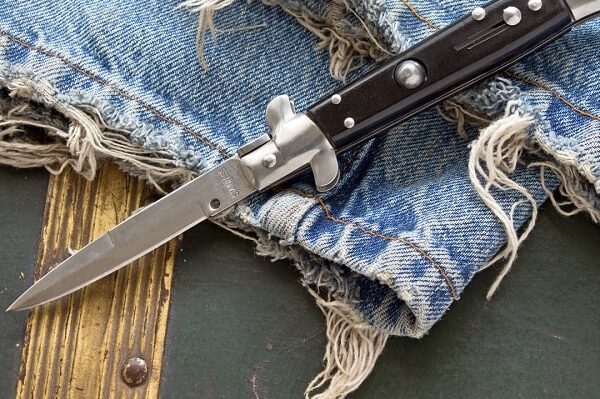
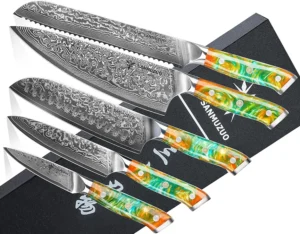

The Stiletto knife has a long, narrow blade designed for piercing materials, soft armor, or people, with little resistance. The knife design was influenced by 15th century Italian daggers. Unlike most daggers or rapiers, the Stiletto usually has a double-edge. Its narrow blade and needle point tip allows for deep penetration into a target.
Classic Stilettos feature a spear point blade with both sides of the blade tapering to the sharp point. This design helps with thrusting motions. Modern Stilettos can be automatic knives where the blade opens at the push of a button or switch.
Early on, the stiletto was used by Italian knights. The thin, needle-like blade allowed the stiletto to penetrate most mail armor or pass through the silts in a knight’s helmet. The stiletto also became the preferred weapon for a “mercy strike”.
Over time, the stiletto became the favorite weapon of the medieval assassin. This blade was silent, easy to conceal, and capable of penetrating leather. In the following centuries the stiletto remained a popular weapon among criminals and political assassins.
The Stiletto was used in hand-to-hand combat during World War 1. Commando raiding forces then used this knife during WW2 for quick, quiet killing of enemy forces. Modern Stilettos have evolved and now include folding, spring-assist, and lock blade options.

Most modern stiletto knives are closer in design to switchblades than their dagger origins. Most stilettos are spring-assisted with manual pressure opening the blade. At this point, a spring propels the blade into an open and locked position.
Thanks to this design, the modern stiletto is easy to open with a single hand. The out the front or OTF design is the most recognizable Stiletto style. A side-opening design is also a popular option.
Stiletto knives are different from many standard knives you might carry every day. While most pocket knives have broader blades designed for cutting and slicing, stilettos focus on stabbing and piercing.
Dagger-style knives also have pointed tips and double edges, but stilettos are generally thinner and have less blade width. Regular switchblade knives are known for their spring-assisted opening, but not every switchblade is a stiletto. Only those with the narrow blade and spear-point tip fit the definition.
The stiletto has gained the reputation as a highly dangerous weapon that has been highly regulated by the law.
Across the US the federal restrictions have relaxed but there are conflicting state laws on blade length, open carry, and concealed carry. For example, in Colorado, non-ballistic knives must not exceed 3.5 inches and cannot be carried concealed outside of your home. But in California, Stiletto blades over 2 inches are banned.
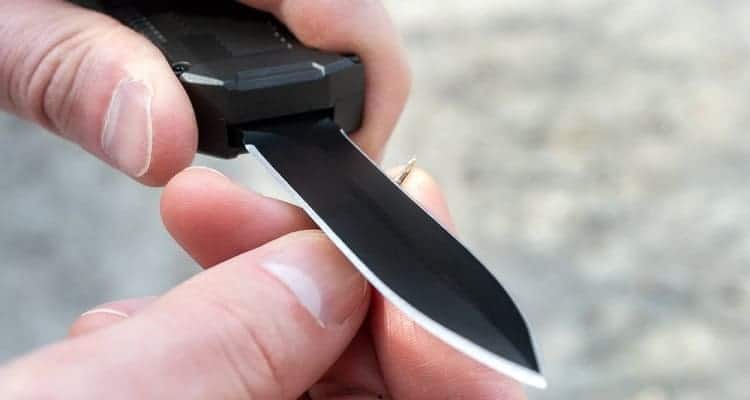
The stiletto knife has a long story shaped by changing needs, skilled knife makers, and cultural influences. Its design and use have shifted over time, yet it remains tied to its roots in Italy and the work of expert craftsmen.
The earliest stilettos appeared in Italy during the late Middle Ages, around the 15th century. These first knives were likely created by knights and craftsmen who wanted a blade that could pierce armor gaps. Unlike wider daggers, the stiletto had a very slim, pointed blade that made it easy to thrust.
The main feature was its sharp point and thin design, making it good for close combat or silent attacks. Many early stilettos did not have sharp cutting edges. They were used mainly for stabbing.
Knife makers focused on improving durability and precision. By the 16th century, more people had access to these knives as skilled craftspeople refined the stiletto’s look and function. Designs often included decorative touches that showed off the maker’s skill.
Italy is closely linked to the history of the stiletto knife. Knife makers in cities like Florence and Naples developed unique styles. The knife became popular among the Italian nobility because it was easy to hide and carry.
Over time, Italian stiletto knives gained a reputation for quality and style. Some craftsmen became quite famous for their work. The knife even played a role in cultural traditions and was sometimes seen as a symbol of honor or defense.
When many Italians moved to places like New Orleans in the 19th century, they brought their knife-making skills with them. This helped spread the popularity of the stiletto outside Italy, especially as a tool for personal defense.
Modern stiletto knives have changed a lot from their early models. Today, they are known for automatic mechanisms, folding blades, and improved materials like stainless steel. New manufacturing methods have made stilettos more affordable and accessible to collectors and everyday users.
Contemporary craftsmen and brands still value traditional design features, but they also use modern techniques to create knives that are safer and more reliable. Many countries have laws that govern the ownership or carrying of stilettos because of their sharp points and original intent.
These knives are now used for tasks like collecting, self-defense, or even utility work. The history of the stiletto shows how craftsmen have balanced tradition and innovation to create a tool that is both practical and iconic.
Stiletto knives are recognized for their sharp, slim blades and quick, reliable action. The materials and construction choices affect how the knife feels, works, and lasts.
The most common stiletto blade is long, thin, and tapers to a sharp point. Blade lengths usually range from 3 to 6 inches. This design is good for piercing but less effective for slicing.
Many stilettos use high-carbon steel for the blade, which holds a sharp edge and is very strong. Some modern stilettos use stainless steel blades for better rust resistance and easy upkeep. Both types can be hardened to stay sharp, but high-carbon versions may need more care to prevent rust.
Automatic or switchblade stilettos often feature a slim profile, so blade thickness is kept minimal for speed and precision. Look for a blade that matches your daily needs—if you want low maintenance, stainless steel is usually best. High-carbon is preferred if edge retention is most important.
A stiletto’s handle keeps your grip steady and comfortable. Traditional handles were made from wood or bone for a classic look and good weight balance. These days, many handles are created from anodized aluminum, which is light and resists corrosion.
Modern designs also include synthetic materials like G-10 or Micarta. These materials are textured for better grip and are very durable against shocks and drops. Some high-end knives combine several materials for a unique feel and look.
The choice of handle material can affect how heavy the knife feels and how well you can control it. If you want a knife that feels light and is easy to carry, look for aluminum or modern synthetic options.
The pivot is the joint where the blade rotates when you open and close your knife. In a stiletto, the pivot must be strong and smooth because these knives are often opened with one hand.
Switchblade stilettos have a spring-loaded pivot, so the blade snaps open with speed. This part is usually made from hardened steel or brass bushings to reduce friction and wear. Strong pivots ensure the knife stays tight and safe during use.
A well-made pivot gives your knife reliability and makes it easy to use. If you notice any looseness or sticking, the pivot may need to be cleaned or adjusted. Regular oiling and wiping help keep the action smooth.
Customization lets you make your stiletto knife unique. Many collectors add hand-made touches like personalized filework. Decorative carving or grooves are made along the blade’s spine or the handle’s edges.
You can pick unique handle materials, add colored liners, or engrave initials. Some makers offer limited edition blades or custom finishes. These touches do not just look special—they can also improve grip or balance.
If you want a truly personal knife, look for brands or makers that offer custom filework, scale choices, or even blade length options. Customization can turn a regular stiletto into a one-of-a-kind piece that shows off your style.
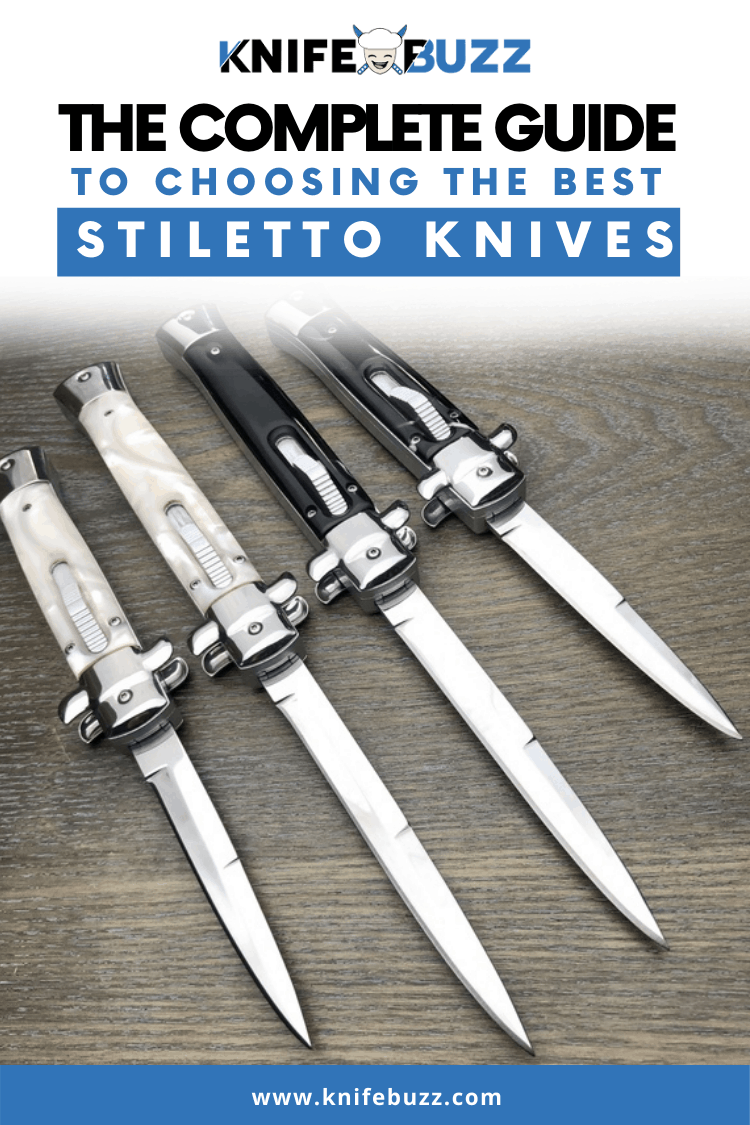
When picking your first stiletto knife, it is important to pay attention to blade length, handle materials, and how well the knife fits your needs. Cost, blade style, and the overall size can make a big difference in your experience.
Start by thinking about what you want to use your stiletto knife for. Most people choose these knives for collection or simple tasks, rather than heavy-duty work. The blade is usually narrow and sharp, making it best for precise cutting or display.
Stiletto blade materials – The blade is usually stainless steel, which resists rust and is easy to maintain. Look for a solid locking mechanism, as safety matters when using any blade. The handle can be made from plastic, wood, or metal, and you should pick one that feels comfortable and not slippery.
Stiletto weight and balance – Hold different knives and choose one that feels good in your hand. If you plan to carry your knife, make sure it is easy to open and close, and not too heavy for your pocket or pack.
If you are new to stiletto knives, there are plenty of affordable models to start with, but the quality can vary. Low-cost options often use lighter materials or simpler designs, but they are a good way to learn what you like.
Watch for common issues like loose blades or weak springs in cheaper knives. Many budget stilettos are made with stamped metal, which may not be as strong as solid steel parts. Reading reviews can help you avoid models that break easily or have poor construction. Buying from known brands also saves you money on repairs or replacements.
The size of your stiletto knife is measured by blade length, with most models ranging from 3 to 6 inches. A short blade, around 3 inches, is easier to carry and fits in most pockets. Longer blades are better for display or specific uses but can be less practical for everyday carry.
Some states and cities limit the length of knife blades you can legally carry, so check your local laws before buying a larger knife. Comfort matters, so pick a handle length that suits your hand without being bulky. Smaller handles are easy to hide but can be hard to grip.
If you are not sure, start with a mid-size stiletto. This gives you a blade that is long enough for most light tasks but still small enough to manage.
Learning to use a stiletto knife safely involves a few simple habits and techniques. Careful cleaning and correct storage help the knife last longer and stay in good working condition.
Always hold your stiletto knife by the handle and keep your fingers away from the blade. Make sure the blade is locked in place before using it. If your knife is a switchblade, avoid flipping it open when not needed.
When practicing with a stiletto or other knife fighting styles, use a training knife to prevent injury. Always point the blade away from your body and others. Try using slow, controlled movements until you feel comfortable.
Never use a stiletto for prying or chopping. This tool is designed for thrusting and precise cutting, not heavy tasks. Using it wrong can damage the knife and increase the risk of accidents.
Keep your stiletto knife clean to prevent rust and buildup. Wipe the blade and handle with a soft cloth after each use. Use a small amount of warm water and mild soap for tough dirt, and dry the knife fully when done.
If your knife has moving parts, add a drop of light oil to the pivot from time to time. This helps keep it opening and closing smoothly. Avoid using harsh cleaners or putting your knife in the dishwasher, as this can damage the metal and handle.
Regular sharpening is also important. Use a simple sharpening stone to keep the edge straight. Always move the blade across the stone at the same angle each time. Following these steps ensures your knife stays reliable and safe to use.
| Do | Don’t |
|---|---|
| Store in a dry place | Leave in damp areas |
| Use a sheath/pouch | Toss it in a drawer |
| Keep out of reach | Leave it unattended |
Store your stiletto knife in a dry place to avoid moisture that can cause rust. A sheath or padded pouch works well for protecting both the blade and your fingers.
Keep your knife away from young children and those unfamiliar with fighting knives. Use a lockable box or case if you want extra safety at home. Avoid leaving your knife where it could get knocked onto the floor or easily found by others.
Proper storage helps prevent both accidents and damage to your stiletto knife.
Stiletto knives come in many styles that offer different features, looks, and ways to use them. Each type appeals to specific uses, from daily carry to collecting or display.
The classic Italian stiletto is the most recognized style, known for its slim and elegant design. It often has a pointed blade, usually made from stainless steel, and a handle crafted from materials such as wood, bone, or synthetic resin.
These knives use a button or lever to deploy the blade quickly, which has led to their reputation in movies and pop culture. Most have a straight, narrow blade made for thrusting rather than slicing. The Italian stiletto is a favorite among collectors due to its historical roots going back to 19th-century Italy.
You will notice unique touches from well-known Italian knife makers, with details like etched bolsters and inlaid handles. Many buyers look for features like a sturdy release spring and traditional tang stamp when picking the best models.
Butterfly stiletto knives blend the flipping action of a butterfly knife with the pointed blade of a classic stiletto. You can open these with your hand by flipping the two handles around the blade. This style is popular for those who like to perform tricks or want a unique way to open their knife.
Switchblade stilettos use an automatic opening system. Pressing a button or lever causes the blade to snap open quickly. These knives are often used for self-defense or quick access, though you need to check your local laws, since some areas restrict switchblade carry.
Most switchblade and butterfly stilettos have modern materials such as aluminum or G-10 handles and may offer safety locks. They combine fast deployment with the signature pointed stiletto blade, giving you both speed and style.
Custom stiletto knives are handmade by skilled knife makers and often show off high-quality materials and expert craftsmanship. Makers may use rare woods, Damascus steel, or add features like engraved bolsters and gemstone inlays.
Collector’s models focus on limited runs, vintage designs, or unique collaborations between popular makers. These knives are often displayed and traded at knife shows. Some rare models, especially authentic Italian stilettos from famous makers, can command high prices.
If you want something unique or an investment piece, custom options allow you to personalize style, blade steel, or handle material. Collector’s pieces give you a look at the rich history and changing trends in the world of stiletto knives.
Choosing the right stiletto knife comes down to design, purpose, and the laws in your area. Price, blade style, and proper care also have a big impact on usefulness and longevity.
You should look at the knife’s blade shape, overall length, and if it has a push-button or manual opening. A comfortable grip and reliable locking mechanism are important for safe handling. If you want an authentic look, some Italian stiletto knives have signature handles and blades.
Keep the blade clean and dry to prevent rust. Regularly oil the pivot and locking mechanism, especially for switchblades. Sharpen the blade with a proper sharpener and store the knife in a sheath or case to avoid damage.
Many areas have restrictions on owning, carrying, or selling switchblade knives. Check your state and local laws before buying a switchblade stiletto. Some regions allow only fixed blade or manual stilettos.
Original stilettos were designed for stabbing, with thin, sharp points and straight edges. Modern versions often add safety features, more durable materials, or assisted-opening systems. Some modern stilettos are wider and are made for general use instead of just piercing.
Longer blades like a 12-inch stiletto can offer reach but may be harder to carry or control. Wavy or serrated blades are better for cutting, while a classic stiletto blade is best for piercing. The right style depends on your intended use.
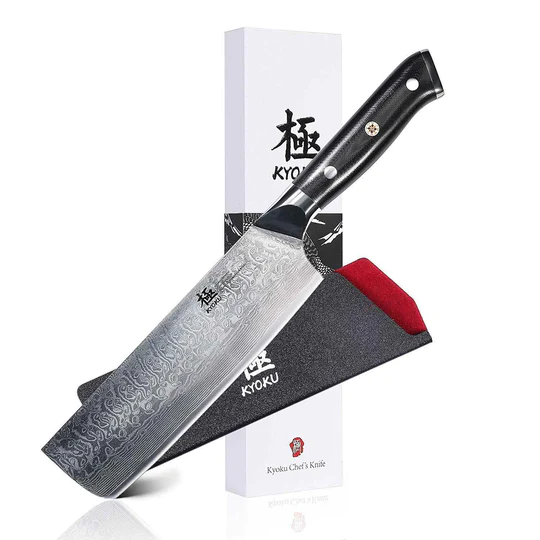
Knife Buzz offers independent product reviews on a wide range of knives used in the kitchen, home, and outdoors. We make it easy for you to find the right knife at the best price.